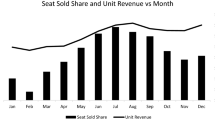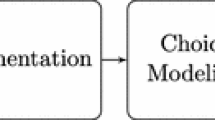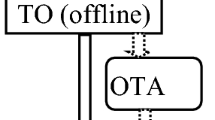Abstract
Travel providers such as airlines are becoming more and more interested in understanding how passengers choose among alternative products, especially the purchasing preferences of passengers. Getting information of air passenger choice behavior helps them better display and adapt their offer. Discrete choice models are appealing for airline revenue management (RM). In this paper, we apply latent class multinomial logit model (LC-MNL) to passenger choice behavior. The analysis based on actual sales transaction data reveals the purchase preferences of different passenger types. According to the distribution of the market, we divide passengers into three groups: low-price oriented, high-price oriented and no specific price preference. The low-price oriented passengers only choose products from the set consisting of the lowest price cabin classes of all flights while the high-price oriented passengers only choose products from the set consisting of the highest price cabin classes of all flights. Considered the passenger types in the transaction sales data are unknown, the latent class passenger choice model can better represent their heterogeneous purchasing preference. A developed EM algorithm is applied to solve the LC-MNL. In the developed EM algorithm, an indicator function containing the type of passengers and first choice information in period t is devised, the iterative process of the EM algorithm is more effective consequently. The proposed model and algorithm are evaluated on actual aviation sales transaction data in China. Experimental results show that the passenger choice behavior analysis based on the specific purchasing preferences performs well on actual aviation sales transaction data.
Access this chapter
Tax calculation will be finalised at checkout
Purchases are for personal use only
Similar content being viewed by others
References
Papola, A.: Some developments on the cross-nested logit model. Transp. Res. Part B 38(9), 833–851 (2004)
Wen, C.H., Wang, W.C., Fu, C.: Latent class nested logit model for analyzing high-speed rail access mode choice. Transp. Res. Part E Logist. Transp. Rev. 48(2), 545–554 (2012)
Li, B.: The multinomial logit model revisited: a semi-parametric approach in discrete choice analysis. Transp. Res. Part B 45(3), 461–473 (2011)
Vulcano, G., Van Ryzin, G., Chaar, W.: Om practice-choice-based revenue management: an empirical study of estimation and optimization. Manuf. Serv. Oper. Manag. 12(3), 371–392 (2010)
Mcfadden, D.L.: Condition logit analysis of qualitative choice behavior. Front. Econometrics 105–142 (1974)
Busquets, J.G., Evans, A.D., Alonso, E.: Application of data mining to forecast air traffic: a 3-stage model using discrete choice modeling. In: AIAA Aviation Technology, Integration, and Operations Conference (2015)
Coldren, G.M., Koppelman, F.S., Kasturirangan, K., Mukherjee, A.: Modeling aggregate air-travel itinerary shares: logit model development at a major US airline. J. Air Transp. Manag. 9(6), 361–369 (2003)
Warburg, V., Bhat, C., Adler, T.: Modeling demographic and unobserved heterogeneity in air passengers’ sensitivity to service attributes in itinerary choice. Transp. Res. Rec. J. Transp. Res. Board 676, 7–16 (2006)
Azadeh, S.S., Hosseinalifam, M., Savard, G.: The impact of customer behavior models on revenue management systems. CMS 12(1), 99–109 (2014). https://doi.org/10.1007/s10287-014-0204-z
Chandukala, S.R., Kim, J., Otter, T., Rossi, P.E.: Choice models in marketing: economic assumptions, challenges and trends. Found. Trends Mark. 2(2), 97–184 (2013)
Zhen, Y., Rai, P., Zha, H., Carin, L.: Cross-modal similarity learning via pairs, preferences, and active supervision. In: Twenty-Ninth AAAI Conference on Artificial Intelligence (2015)
Kamakura, W.A., Russell, G.J.: A probabilistic choice model for market segmentation and elasticity structure. J. Mark. Res. 26(4), 379–390 (1989)
Wedel, M., Kamakura, W.: Market Segmentation: Conceptual and Methodological Foundations, 2nd edn. Kluwer Academic Publishers, Boston (2000)
Lee, H., Eun, Y.: Discovering heterogeneous consumer groups from sales transaction data. Eur. J. Oper. Res. 280(1), 338–350 (2020)
Pancras, J., Dey, D.K.: A comparison of generalized multinomial logit and latent class approaches to studying consumer heterogeneity with some extensions of the generalized multinomial logit model. Appl. Stoch. Model. Bus. Ind. 27(6), 567–578 (2011)
Mottini, A., Acuna-Agost, R.: Deep choice model using pointer networks for airline itinerary prediction. In: Proceedings of the 23rd ACM SIGKDD International Conference on Knowledge Discovery and Data Mining, pp. 1575–1583 (2017)
Osogami, T., Otsuka, M.: Restricted Boltzmann machines modeling human choice. In: Advances in Neural Information Processing Systems, vol. 27, pp. 73–81 (2014)
Hruschka, H., Fettes, W., Probst, M.: Analyzing purchase data by a neural net extension of the multinomial logit model. In: Dorffner, G., Bischof, H., Hornik, K. (eds.) ICANN 2001. LNCS, vol. 2130, pp. 790–795. Springer, Heidelberg (2001). https://doi.org/10.1007/3-540-44668-0_110
Train, K.E.: Discrete Choice Methods with Simulation. Cambridge University Press, Cambridge (2009)
Rusmevichientong, P., Shen, Z.J.M., Shmoys, D.B.: Dynamic assortment optimization with a multinomial logit choice model and capacity constraint. Oper. Res. 58(6), 1666–1680 (2010)
Author information
Authors and Affiliations
Corresponding author
Editor information
Editors and Affiliations
Rights and permissions
Copyright information
© 2021 Springer Nature Switzerland AG
About this paper
Cite this paper
Li, X., Gao, S., Yang, W., Si, Y., Liu, Z. (2021). Purchase Preferences - Based Air Passenger Choice Behavior Analysis from Sales Transaction Data. In: Wu, W., Du, H. (eds) Algorithmic Aspects in Information and Management. AAIM 2021. Lecture Notes in Computer Science(), vol 13153. Springer, Cham. https://doi.org/10.1007/978-3-030-93176-6_26
Download citation
DOI: https://doi.org/10.1007/978-3-030-93176-6_26
Published:
Publisher Name: Springer, Cham
Print ISBN: 978-3-030-93175-9
Online ISBN: 978-3-030-93176-6
eBook Packages: Computer ScienceComputer Science (R0)




